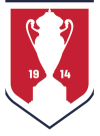Metro New York, which includes all five of NYC’s boroughs and parts of New Jersey, lays claim to 17 separate Open Cup winners with 25 titles shared between them. That includes the inaugural Champions, Brooklyn Field Club, from back in 1914. The only New York-based team to be crowned Open Cup Champs and to not call Metro New York home are upstate combatants the Rochester Ragin’ Rhinos, who became the only non-MLS-based Champion in the MLS Era of the Open Cup in 1999.
Join ussoccer.com for a look back at all the champions from in and around the Big Apple, a long-time soccer hotbed and immigration destination since even before Lady Liberty first lifted her lamp beside the golden door.
1913-14: Brooklyn Field Club 2-1 Brooklyn Celtic
1920-21: Brooklyn Robbins Dry Dock 4-2 Scullin Steel
1921-22: Scullin Steel 3-2 Todd Shipyards
1922-23: Paterson FC 2-2, 3-0 (forfeit) Scullin Steel
1928: New York Nationals 4-1 (agg) Chicago Bricklayers
1928-29: New York Hakoah 5-0 (agg) St. Louis Madison Kennel
1937: New York Americans 5-2 (agg) St. Louis Shamrocks
1939: Brooklyn St. Mary’s Celtic 5-1 Chicago Manhattan Beer
1943: Brooklyn Hispano 5-4 (agg) Morgan Strasser
1944: Brooklyn Hispano 4-0 Morgan Strasser
1945: Brookhattan 6-2 Cleveland Americans
1951: New York German-Hungarian SC 8-6 (agg) Heidelberg SC
1954: New York Americans 3-1 (agg) St. Louis Kutis SC
1955: SC Eintracht 2-0 Los Angeles Danes
1962: New York Hungaria 3-2 San Francisco Scots
1965: New York Ukrainians 5-2 (agg) Chicago Hansa
1967: Greek American AA 4-2 Orange County Soccer Club
1968: Greek Americans AA 2-1 (agg) Chicago Olympic
1969: Greek American AA 1-0 Montabello Armenians
1970: Elizabeth SC 2-1 Los Angeles Croatia
1971: New York Hota 6-4 San Pedro Yugoslavs
1972: Elizabeth SC 1-0 San Pedro Yugoslavs
1974: Greek American AA 2-0 Chicago Croatian
1979: Brooklyn Dodgers 2-1 Chicago Croatian
1980: New York Pancyprian-Freedoms 3-2 Maccabi Los Angeles
1982: New York Pancyprian-Freedoms 4-3 Maccabi Los Angeles
1983: New York Pancyprian-Freedoms 4-2 St. Louis Kutis SC
1984: New York AO Krete 4-2 San Pedro Yugoslavs
1991: Brooklyn Italians 1-0 Richardson Rockets
No less than 19 U.S. Open Cup Finals (or Final legs) have been played in the NYC area in the last 110 years, at mythical grounds like the Eintracht, Zerega and Metropolitan Ovals, the long-gone Polo Grounds (seen in the top photo at the top of this story) and Randall’s Island. Scroll on for a rare photographic look back at the enduring love affair between America’s oldest soccer tournament and its most famous city.








































